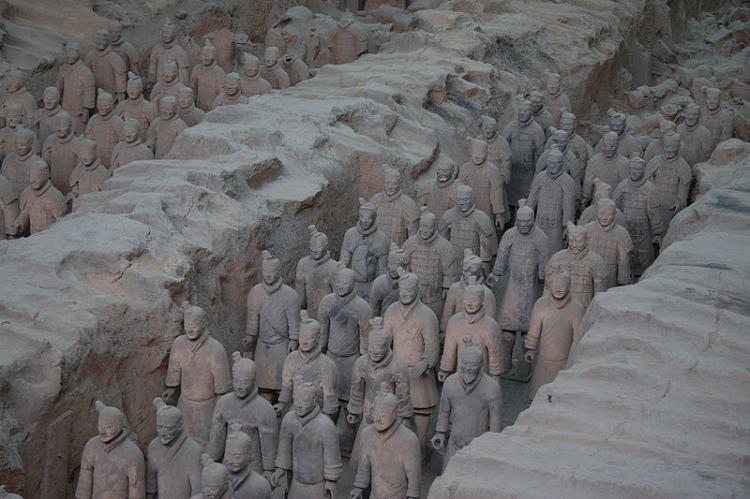The discovery of the Terracotta Army is one of the fascinating stories of archeology.
Consisting of life-size figures in terracotta of over 8,000 soldiers, 130 chariots with 520 horses and 150 cavalry horses, arranged in three pits, this army represents an artistic marvel of Chinese culture from 210 BC. It was excavated in 1974, in the Lintong District of Xi’an, the capital of Shaanxi Province, near the Mausoleum of the First Qin Emperor,
There is a legend associated with the discovery. A farmer stumbled upon a brick wall while he was digging a vegetable cellar. He tentatively made a chink in the wall. Looking through the hole, he was shocked and surprised to see a large majestic array of soldiers standing there.
The terracotta images were so lifelike, with bright piercing eyes and perfect colors, that he was scared to death. He quickly plugged the hole and reported it to the local archaeological department.
On hearing his report, the archaeologists thought that the farmer had chanced upon a grave and had a hallucination due to hypoxia below ground level. Then an archaeologist was sent there to find out the details. When the hole in the wall was opened again, the archaeologist saw what the farmer reported.
It was the stunning sight of a complete army in action! The deafening noise of the war cry and sand swirling fiercely around the speeding horses—a scene of war in the Qin Dynasty was right in front of his eyes.
Slowly, the cloud of sand subsided and the sound vanished. The terracotta warriors in the grave started showing signs of aging. Their colors receded and their eyes turned dull. Many heads and arms broke off and the scene changed to what we see of it today.
The Terracotta Army is a specimen of funerary art, buried with the First Emperor of Qin in 210-209 BC. It was believed that the army would follow the emperor Qin Shi Huang to another empire in the afterlife.
The archeological site is preserved as a UNESCO world heritage site.
A collection of 120 objects from the mausoleum and 20 terracotta warriors were displayed at the British Museum in London in a special exhibition “The First Emperor: China’s Terracotta Army” from September 13, 2007 to April 2008.
The exhibition drew great crowds and was a resounding success. According to The Times, many people had to be turned away from the exhibition, despite viewings until midnight. The exhibition subsequently traveled to the United States, Canada, Sweden, and Australia. It is now back in Canada, hosted by the Montreal Museum of Fine Arts until June 26, 2011.
[email protected]
Consisting of life-size figures in terracotta of over 8,000 soldiers, 130 chariots with 520 horses and 150 cavalry horses, arranged in three pits, this army represents an artistic marvel of Chinese culture from 210 BC. It was excavated in 1974, in the Lintong District of Xi’an, the capital of Shaanxi Province, near the Mausoleum of the First Qin Emperor,
There is a legend associated with the discovery. A farmer stumbled upon a brick wall while he was digging a vegetable cellar. He tentatively made a chink in the wall. Looking through the hole, he was shocked and surprised to see a large majestic array of soldiers standing there.
The terracotta images were so lifelike, with bright piercing eyes and perfect colors, that he was scared to death. He quickly plugged the hole and reported it to the local archaeological department.
On hearing his report, the archaeologists thought that the farmer had chanced upon a grave and had a hallucination due to hypoxia below ground level. Then an archaeologist was sent there to find out the details. When the hole in the wall was opened again, the archaeologist saw what the farmer reported.
It was the stunning sight of a complete army in action! The deafening noise of the war cry and sand swirling fiercely around the speeding horses—a scene of war in the Qin Dynasty was right in front of his eyes.
Slowly, the cloud of sand subsided and the sound vanished. The terracotta warriors in the grave started showing signs of aging. Their colors receded and their eyes turned dull. Many heads and arms broke off and the scene changed to what we see of it today.
The Terracotta Army is a specimen of funerary art, buried with the First Emperor of Qin in 210-209 BC. It was believed that the army would follow the emperor Qin Shi Huang to another empire in the afterlife.
The archeological site is preserved as a UNESCO world heritage site.
A collection of 120 objects from the mausoleum and 20 terracotta warriors were displayed at the British Museum in London in a special exhibition “The First Emperor: China’s Terracotta Army” from September 13, 2007 to April 2008.
The exhibition drew great crowds and was a resounding success. According to The Times, many people had to be turned away from the exhibition, despite viewings until midnight. The exhibition subsequently traveled to the United States, Canada, Sweden, and Australia. It is now back in Canada, hosted by the Montreal Museum of Fine Arts until June 26, 2011.
[email protected]







